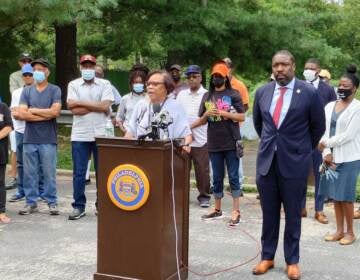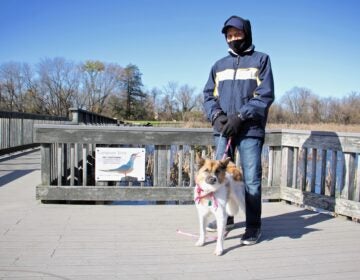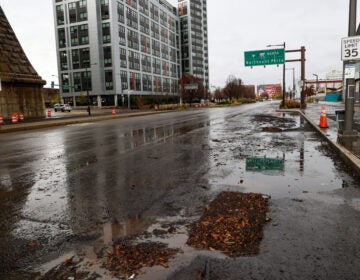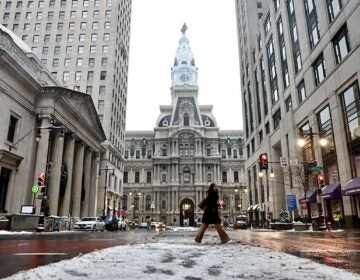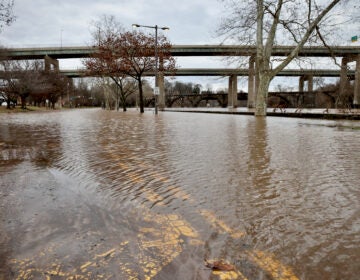Eastwick residents could become Philly’s first climate migrants. A new plan sees them moving to city-owned higher ground
Under the proposal, a land swap, residents would get to stay in Eastwick. It avoids the limitations and red tape of federal programs, supporters say.
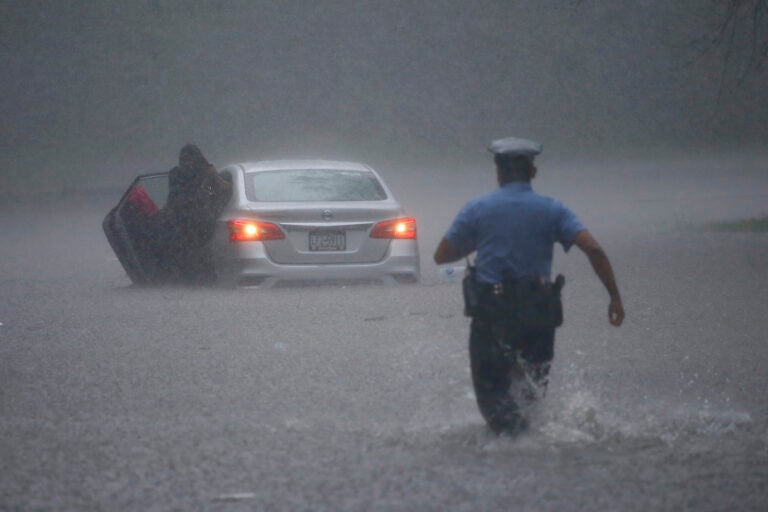
A Philadelphia police officer rushes to help a stranded motorist during Tropical Storm Isaias, Tuesday, Aug. 4, 2020, in Philadelphia. (AP Photo/Matt Slocum)
After decades of intense flooding and failed or discarded plans to help Eastwick residents face increasingly high waters, a new proposal aims to make homeowners in the Southwest Philadelphia neighborhood whole through a land swap.
Simply put, those now living in flood-prone Eastwick would move to newly built housing on higher ground that is currently owned by the city. The homeowners might become the city’s first climate migrants — forced from their homes due to rising sea levels and increased rain events that make it impossible to continue living in low-lying areas.
The proposal, presented to residents at an event Saturday night at the Academy of Natural Sciences, would avoid the limitations and red tape associated with federal programs that fund climate migration, according to Carolyn Moseley, of Eastwick United Community Development Corp.
Moseley knows those programs well: She worked for the city as a certified relocation specialist in the Office of Housing and Community Development before retiring after 26 years.
“Relocation does not make you whole,” she said. “It gets you out, but where are you going to go?”
Moseley came up with the land swap idea and teamed up with researchers from Drexel University and the Stevens Institute of Technology. They surveyed the residents, dozens of whom live in homes facing repeated flooding or in sinking homes built on silt. She said most of the residents want to stay in Eastwick.
“The objective is to make these folks whole,” said Moseley, herself a resident of Eastwick. “People don’t want to leave their community. They are taxpayers, residents, and voters, and they deserve better than this.”
An urban renewal project in the 1950s displaced about 8,000 residents and businesses, and in their place homes were built atop wetlands in one of the lowest lying areas of the city, near Philadelphia International Airport. Some of the original homes were built on top of silt, and are now sinking. Eastwick, a primarily Black neighborhood, sits at the confluence of the Cobbs and Darby creeks, both of which are tidal and were prone to flooding even before climate change led to increased rain events and sea level rise.
The Army Corps of Engineers has been working on plans to mitigate flooding in the area for more than a decade. A 2014 report concluded that a $2.8 million levee was feasible and would stop some of the flooding in Eastwick, but that it would push the water elsewhere and possibly flood neighboring communities in Delaware County. In 2019, the city’s Water Department partnered with the Army Corps to do a follow-up $3 million study. That research is ongoing.
But Moseley said time is running out. “I mean 20 years, what is it that they don’t know and have to continue studying?” she asked.
In 2018, Philadelphia put forth a plan for Eastwick, issuing two requests for proposals to redevelop some vacant parcels. But those plans, which included low-income senior housing that few of the current residents qualified for, were rejected, according to Moseley.
“One recommendation was just buy them out, get them out of here,” she said.
The newly proposed land swap, however, would allow residents to stay. Homeowners would transfer property rights to the city in exchange for new homes built on vacant city-owned land that is in a 500-year floodplain and less prone to frequent flooding. The surrendered land — which would include unused wetlands next to the John Heinz National Wildlife Refuge as well as the city-owned land sitting on higher ground, in total about 128 acres — would become a community land trust. The low-lying wetland portions would be sold to a conservation foundation.
The idea is that the conservation foundation would then turn the land over to the Heinz Refuge to be managed. Proceeds from the sale of the wetlands portion would go to build new homes, and provide tax credits for those invested in the conservation foundation.
“We can dictate our own terms, because now the land is owned by the community,” said Moseley.
Things in Eastwick are further complicated by a Superfund site, the Clearview Landfill. The Environmental Protection Agency says it is one of the nation’s most contaminated areas, and it is now in the midst of a massive $76 million remediation to clear and remediate toxic soil.
Hundreds of Eastwick residents still struggle with the fallout from Tropical Storm Isaias, which devastated the neighborhood in August 2020, Moseley said. Sixty families were either without flood insurance or were underinsured, she said, causing some to go without heat or hot water last winter. The area failed to get sufficient recovery aid after it was not declared a disaster area. Instead, residents relied on volunteers and fundraisers.
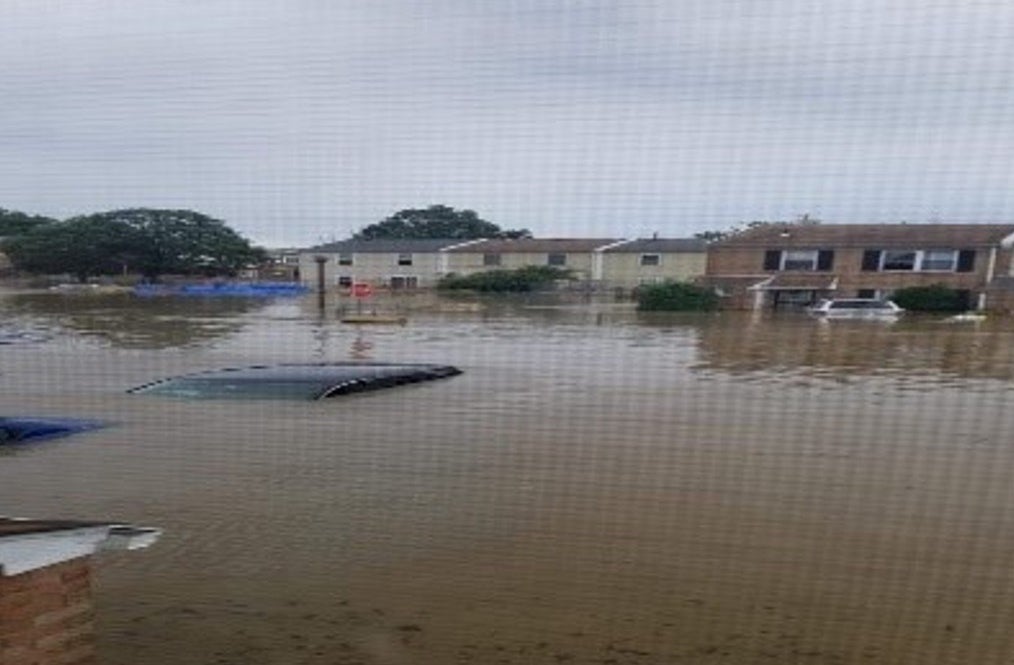
Moseley contrasted that response with the flood relief given to residents of Bucks County after the remnants of Hurricane Ida devastated the region in September.
“It’s like nobody is helping us, and then we read in the paper that other communities have gotten assistance,” she said. “And they’re not communities of color. We’re a community of color, and nobody is doing anything.”
Politicians who represent Eastwick, such as City Councilmember Kenyatta Johnson and U.S. Rep. Mary Gay Scanlon, are on board with the idea, Moseley said, but she has yet to meet with city officials.
“We are all, including city government down to the residents, we are all living with mistakes from the past,” she said, “but we can get it right.”
WHYY is your source for fact-based, in-depth journalism and information. As a nonprofit organization, we rely on financial support from readers like you. Please give today.



